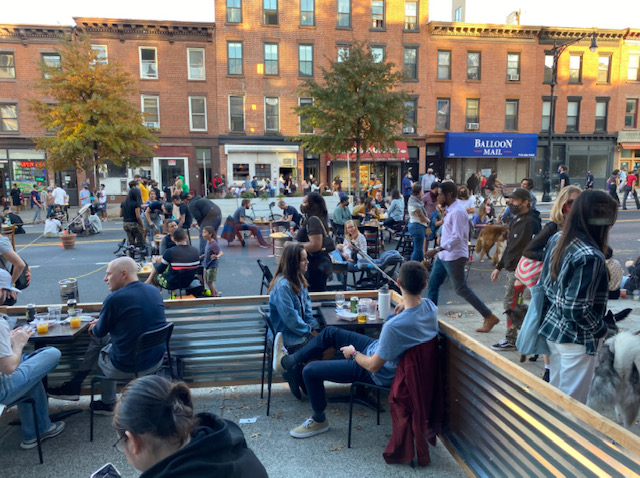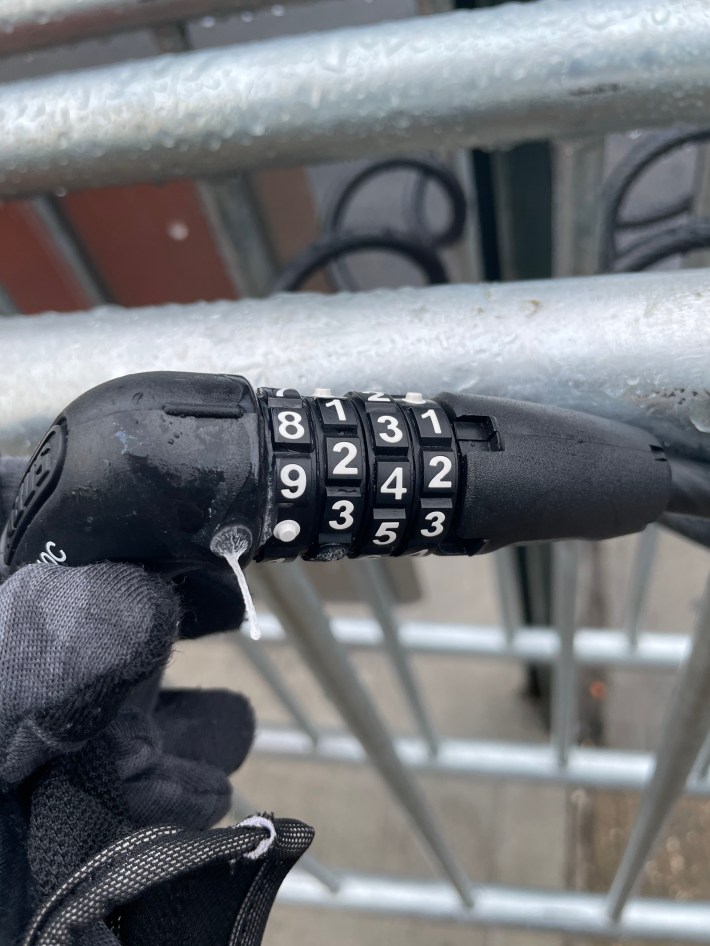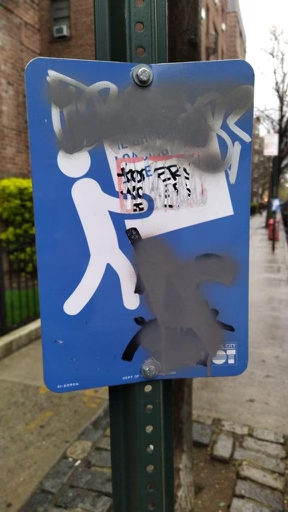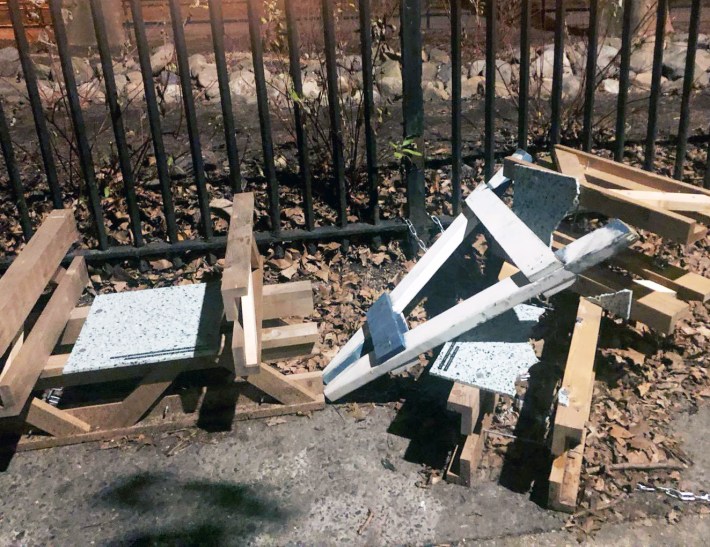ANALYSIS: Mayor de Blasio Has Abandoned the Open Streets ‘Program’
12:01 AM EDT on April 12, 2021

Vanderbilt Avenue in Brooklyn is a successful open street, but too many others have challenges. It will take a city focus on public space management to ensure that people-centered placemaking thrives. File photo: Prospect Heights Neighborhood Development Council
Open streets or open warfare?
The mayor's signature effort to bring car-free outdoor space to COVID-stricken neighborhoods last year is increasingly looking like it will collapse unless city officials do something to assert authority over a program that has left volunteers beaten, harassed, uncompensated and just plain exhausted. Consider what's happened in just the last few days:
- An open streets volunteer was attacked by a car owner in North Brooklyn last week.
- Open streets opponents are discussing in private chat rooms whether they can apply to run an open street — and then simply not put out the barricades that deter drivers.
- Equipment paid for by volunteers in North Brooklyn was vandalized and destroyed last week, and the open streets program in the Greenpoint part of the neighborhood was suspended over the weekend.
- Two Department of Transportation officials were so viciously berated by open streets opponents in Greenpoint that they withdrew from a meeting last week.
- Some open streets opponents have joined forces and are discussing a class-action lawsuit that will argue that the city is violating drivers' rights by removing thru-traffic from a tiny number of streets.
- Several groups of open streets opponents are circulating petitions with inaccurate information to suggest that open streets are only supported by a fringe of the neighborhood (one petition, in North Brooklyn, even claims that 1,000 parking spaces are going to be eliminated because of the open streets program, and that roadways are less safe when drivers don't have access to them, neither of which is accurate).

Taken all together, it combines to a "program" that is not a program at all, but a collection of hastily assembled volunteer groups struggling mightily to prop up an open space initiative that itself was hastily assembled at the start of the pandemic last year.
The pro-open streets petitions (here's one from TransAlt and here's an independent one) generally advocate for the program in the same way that the de Blasio administration has championed it: as an indispensable open space program that has made our city better.
But there's a fatal flaw: the mayor says that open, car-free space adds to New Yorkers' quality of life whether there is a pandemic or not, but he has not revealed the details of what his "permanent" open streets program will look like — and opponents are filling the chasm of leadership by questioning why streets need to be set aside for social distancing if the need to socially distance itself fades.
A big problem is confusion. People on both sides of this debate-that-shouldn't-even-be-a-debate are complaining that they simply don't know who's in charge, so they don't know who's accountable.
bringing this back for your sunday morning. death threats & false claims have always come before the #decarification of a neighborhood. the only question is, will @nycgov / @nycmayor have the back of #openstreets volunteers? /cc @GershKuntzman https://t.co/V80gLVVYUs
— noel hidalgo • 🗽❤️🔥🚲 (@noneck) April 11, 2021
A meeting of the Queens Community Board 3 Traffic and Transportation Committee last week featured some of the usual irrational fears of the pro-car crowd, but mostly, members of the committee kept asking DOT for its plans.
For instance, some residents complained that there is more trash on 34th Avenue as a result of the many residents now using it for recreation, safe interactions with their neighbors or to enjoy the quiet and cleaner air of a rare car-free space. And, yes, there is trash, which tends to happen wherever humans gather.
Others asked bizarre questions about families hosting birthday parties on the park-like street. Others complained about vendors, who simply go where the people are and tend to offer what people want. Others asked about the open streets volunteer group that the DOT selected to run the program. Others asked why 34th Avenue was chosen at all.
Open-streets skeptics have raised similar questions in North Brooklyn.
Due to vandalism of Driggs Ave & Russell Ave barriers, the #openstreets program is suspended for Sunday, April 11. If you have any information about malicious activity on Friday night, we encourage you to contact Capt Fahey or OFC Molina at @NYPD94Pct.
— North Brooklyn Open Streets (@nbkopenstreets) April 11, 2021
Of course, the questions themselves are not unreasonable — but the questions only point to the logical answer: The city needs to take control of this unique, life-changing, much-loved program and use city resources. The buck needs to stop with someone at City Hall.
And there are many options that will create great open space — and clarity. In other words, if 34th Avenue between Junction Boulevard and 69th Street was simply converted into a park, it would be run as a park, with the Parks Department overseeing sanitation, permitting rules, vending rules, and complaints from the public. If 34th Avenue was converted into a DOT plaza, it would be run as a DOT plaza, with existing DOT plaza rules, permitting rules, vending rules. If the future of 34th Avenue calls for a new design or capital expense, it would be redesigned as a Department of Design and Construction project, which would be run as a Department of Design and Construction project, with existing Department of Design and Construction rules, etc.
You get the idea.
The problem is, the de Blasio administration has chosen confusion, which stems from the emergency creation of the open streets program in the first place. When peppered with questions about the program at last week's CB3 meeting, DOT official Jason Banrey made it very clear that the de Blasio administration's idea of "permanent" still relies on citizen volunteers.
"The city needs the help of volunteers," Banrey said. "They breathe life into the program and make it happen."
They're also cannon fodder. On Thursday, North Brooklyn volunteer Rick Karr was assaulted by an opponent of the open street program on Driggs Avenue, a roadway often used as a shortcut through the neighborhood for drivers exiting the Kosciuszko Bridge. Karr declined to provide details because it's now a legal matter, but some details could be gleaned from witnesses and the police report.
At around 5 p.m. on Thursday, Karr noticed that the barricades at Driggs and Morgan avenues had been moved to the sidewalk, so he started to redeploy them to re-establish the open street. A neighbor started screaming at him, "Oh, no you don't! Oh, no you don't! We just took those down, you're not putting them back up."
The neighbor approached and grabbed one of the barricades that Karr was re-installing — and did so in a way that sent the volunteer to the ground, where he received scrapes from the barricade. Karr withdrew to a nearby store to escape the screaming neighbor, while a witness called the 94th Precinct. By the time the squad car arrived, the belligerent neighbor had fled. Cops took a report, but no arrest has been made (police declined to comment for this story).
The incident with Karr puts a klieg light on the most glaring problem with de Blasio's approach to the open streets program that he says will continue forever despite failing to remedy the underlying tension that has persisted during his seven-plus-year tenure: the car-owning minority sees every streetscape improvement as a "war on cars," while the vast majority of New Yorkers who don't own a car rightly feel that their neighbors' use of a car endangers them, pollutes the air, congests the roadways and generally makes life intolerable in vast stretches of New York City.

"I have lived in Greenpoint for 21 years, but the perpetrator of the assault on me kept saying that I and people like me aren't welcome here and that we're not real Greenpointers," Karr said. "For the most part, we don't own cars. We don't drive to work every day. The old timers tend to drive to and from work every day. That has metastasized into a feeling on their part that their way of life is under attack. And once that happens, it's very difficult to make a case [for open streets] to anyone who feels that."
Correct — but why are volunteers like Rick Karr even in the position of having to "make a case" at all? Why are DOT officials whispering to open streets volunteers to step up their public advocacy to give them cover, we've learned, when it should be the other way around?
"How can this city sustain a program like this completely dependent on volunteer labor and flimsy barricades?" asked Noel Hidalgo, who is involved in the North Brooklyn effort and favors street redesigns to do the bulk of the work of keeping thru-traffic at bay.
"The open street on Driggs can easily be implemented by flipping the direction of one or two blocks," he said. "That would immediately calm the traffic on a quarter-mile stretch with two elementary schools and the neighborhood's largest park. That type of simple change would save this open street. The DOT toolkit is available: flipping streets, putting down planters, adding jersey barriers. It comes down to how much effort this mayor is willing to make to ensure that this legacy-defining program is implemented."
Karr said he favored tight chicanes to slow down traffic, but such a solution, or the ones proposed by Hidalgo are the stuff that DOT tends to present at "visioning" sessions, but never seems to install. (And the agency did not respond to several increasingly urgent requests this weekend to comment for this story, even when told of the injuries sustained by an open streets volunteer.)
Given Bill de Blasio's seemingly unique ability to be hated simultaneously by progressives and conservatives during his mayoralty, it should surprise no one that the mayor's failure to create a clear program with clear designs and clear accountability frustrates the open streets supporters and also the opponents. One woman, who lives in the McGolrick Park area and started an anti-open streets petition on Change.org, is also upset that a program created by the city isn't run by the city.

"This was started as a COVID program and it largely worked, but if this is going to continue, we need to know things like the hours, who's in charge, what will be done about the trash, how will people who do have cars get around," she said. "When I try to voice these concerns to people who have some kind of power, I get accused of attacking or misleading. The so-called 'anti-open streets' people are painted as vicious car-loving eco-terrorists. And that is really not the case." (Well, except in the case of Rick Karr, or the people who vandalized the locks, or the people who run over and destroy barricades or the people who tossed all the new barricades into McGolrick Park the other day, or ...)
The original petition didn't do itself any favors thanks to a glaring inaccuracy — including an allegation that 1,000 parking spaces would be removed in the neighborhood. (The petition has been updated in the "updates" tab, but few people read through those.) The opponent claims she just wants the questions about the program resolved (she also claims she's been harassed by open-streets supporters).
And it's fair to point out that some open streets that were created in the crucible of the pandemic weren't ideal given specific neighborhood logistics (reminder: one of the city's original open streets was Prospect Park West in Park Slope, but that was quickly abandoned when residents of the side streets pointed out how much traffic was being rerouted down their once-quiet roadways). There's no reason that open streets that don't work perfectly can't be switched out for other open streets that would work better — well, no reason except that the DOT open streets process is simply to field applications from various volunteer groups rather than plan a network of open streets based on the agency's knowledge and experience.
This same person was at the meeting on Wednesday when two DOT employees were so verbally abused that they withdrew. It took place in the 94th Precinct station house, and was meant to be a small session featuring two open streets opponents (not this person) who demanded a meeting with DOT so that they, like the open streets volunteers, could have direct communication with city officials.
It didn't go well. First, one attendee, a veteran, threatened to remove his pants to show off bullet wounds he sustained in one of America's many wars, apparently an effort to show that DOT isn't even listening to the needs of veterans (who own cars).
Then, according to our source, it got even more heated, with two opponents speaking belligerently to DOT officials Kyle Gorman and Ronda Messer, who tried to respond but then left.
"I was there just as an observer," she said. "The DOT people were being shouted at and being interrupted. So it was very understandable that they left. I don't know how you can be expected to remain calm as people are screaming at you."
It's unclear what happens next. And that is a problem.
The irony, of course, is that hundreds of thousands of New Yorkers — even many who own cars — are enjoying the de Blasio administration's open streets. Over the weekend, Streetfilms visited four of the best ones, and the resulting video makes a strong argument that the city should do something fast.
Gersh Kuntzman is editor in chief of Streetsblog NYC and Streetsblog USA. He also writes the Cycle of Rage column, which is archived here.
Read More:
Stay in touch
Sign up for our free newsletter
More from Streetsblog New York City
Stockholm Leader’s Message to NYC: ‘Congestion Pricing Just Works’
"In Stockholm, people really thought that congestion pricing would be the end of the world, the city will come to a standstill, no one would be able to get to work anymore and all the theaters and shops would just go bankrupt. None of that happened."
Friday’s Headlines: Trump Trial Trumps Safety Edition
Is anyone going to bother to fix the dangerous mess on the streets and plazas around the Trump trial? Plus more news.
Adams Offers Bare Minimum to Seize Congestion Pricing’s ‘Space Dividend’ Opportunity
The mayor's list of projects supposedly meant to harness congestion pricing's expected reduction in traffic is mostly old news, according to critics.
OPINION: Congestion Pricing Will Help My Family Get Around As We Navigate Cancer Treatment
My partner was recently diagnosed with cancer. Congestion pricing will make getting her to treatment faster and easier.




